ECON 601 Economics Assignment: Business Cycle and China
VerifiedAdded on 2022/10/18
|7
|1050
|22
Homework Assignment
AI Summary
This economics assignment delves into the current contraction cycle of the economy, emphasizing the decline in real GDP growth rates, inflation, and employment. The assignment examines the impact of a trade war between the US and China, analyzing how tariffs affect China's GDP, producer surplus, and employment. It also explores the role of China's middle class in potentially boosting the economy through increased spending and discusses how consumer confidence influences aggregate demand and economic output in both the short and long run. The analysis includes diagrams illustrating these economic concepts and references relevant academic sources.
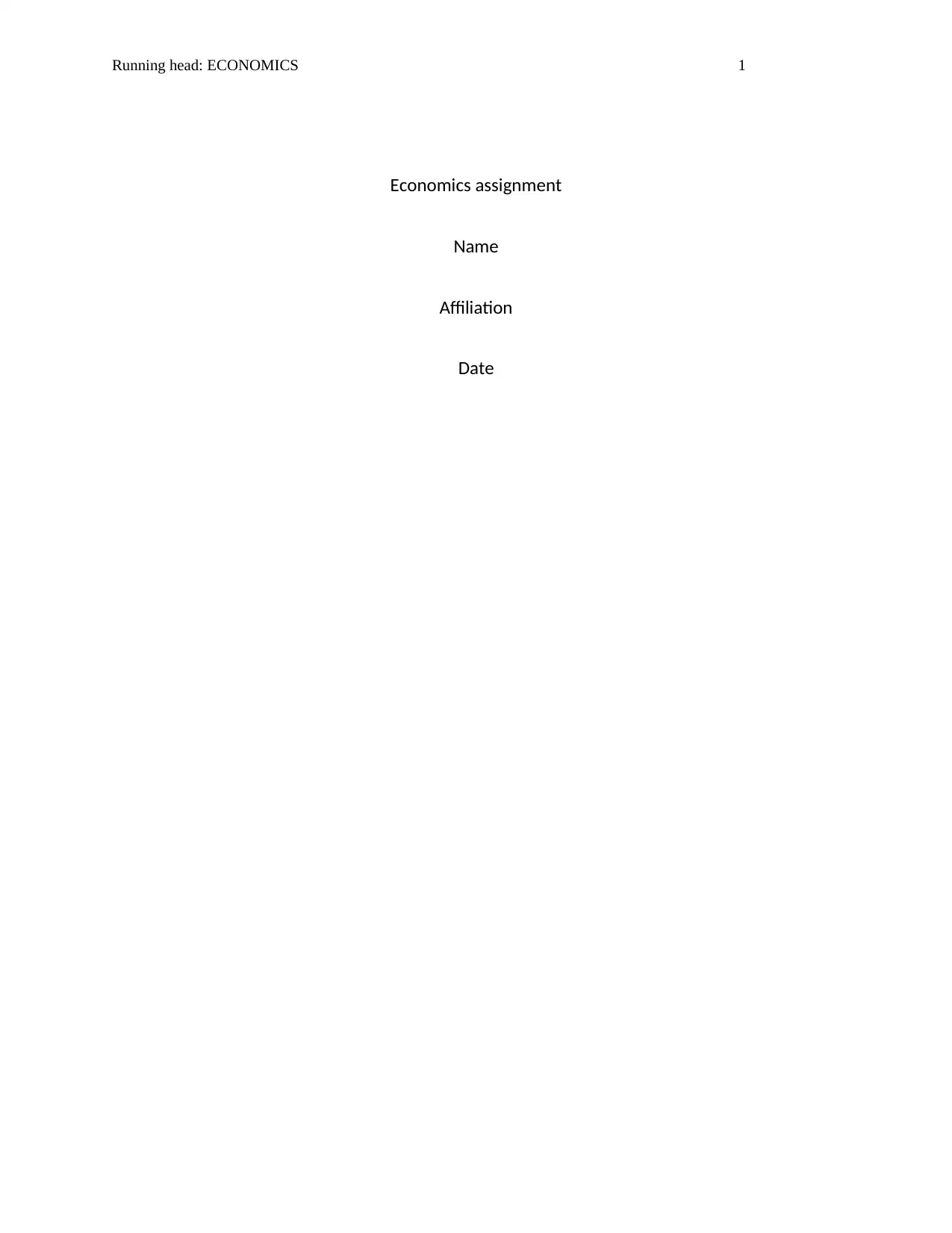
Running head: ECONOMICS 1
Economics assignment
Name
Affiliation
Date
Economics assignment
Name
Affiliation
Date
Paraphrase This Document
Need a fresh take? Get an instant paraphrase of this document with our AI Paraphraser
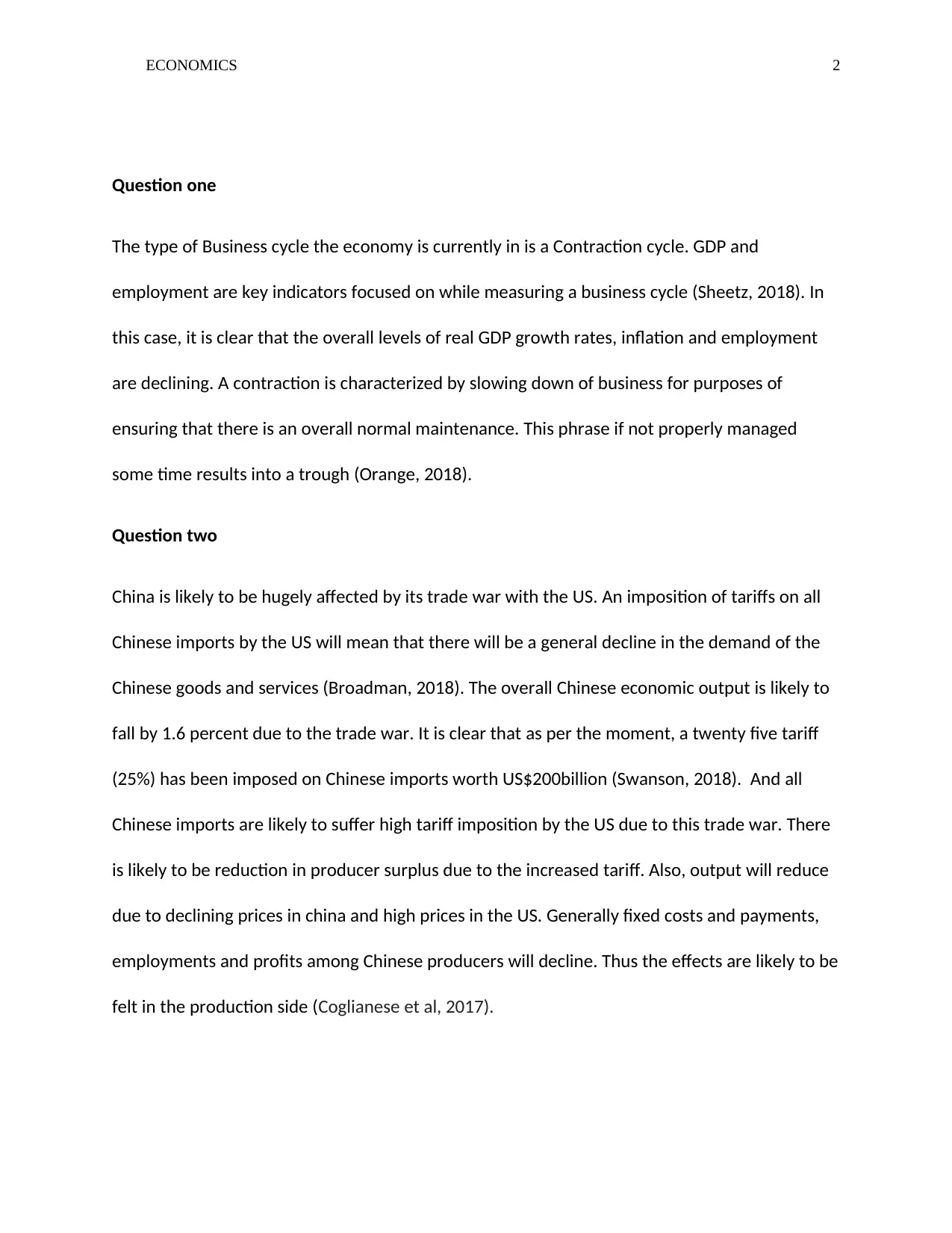
ECONOMICS 2
Question one
The type of Business cycle the economy is currently in is a Contraction cycle. GDP and
employment are key indicators focused on while measuring a business cycle (Sheetz, 2018). In
this case, it is clear that the overall levels of real GDP growth rates, inflation and employment
are declining. A contraction is characterized by slowing down of business for purposes of
ensuring that there is an overall normal maintenance. This phrase if not properly managed
some time results into a trough (Orange, 2018).
Question two
China is likely to be hugely affected by its trade war with the US. An imposition of tariffs on all
Chinese imports by the US will mean that there will be a general decline in the demand of the
Chinese goods and services (Broadman, 2018). The overall Chinese economic output is likely to
fall by 1.6 percent due to the trade war. It is clear that as per the moment, a twenty five tariff
(25%) has been imposed on Chinese imports worth US$200billion (Swanson, 2018). And all
Chinese imports are likely to suffer high tariff imposition by the US due to this trade war. There
is likely to be reduction in producer surplus due to the increased tariff. Also, output will reduce
due to declining prices in china and high prices in the US. Generally fixed costs and payments,
employments and profits among Chinese producers will decline. Thus the effects are likely to be
felt in the production side (Coglianese et al, 2017).
Question one
The type of Business cycle the economy is currently in is a Contraction cycle. GDP and
employment are key indicators focused on while measuring a business cycle (Sheetz, 2018). In
this case, it is clear that the overall levels of real GDP growth rates, inflation and employment
are declining. A contraction is characterized by slowing down of business for purposes of
ensuring that there is an overall normal maintenance. This phrase if not properly managed
some time results into a trough (Orange, 2018).
Question two
China is likely to be hugely affected by its trade war with the US. An imposition of tariffs on all
Chinese imports by the US will mean that there will be a general decline in the demand of the
Chinese goods and services (Broadman, 2018). The overall Chinese economic output is likely to
fall by 1.6 percent due to the trade war. It is clear that as per the moment, a twenty five tariff
(25%) has been imposed on Chinese imports worth US$200billion (Swanson, 2018). And all
Chinese imports are likely to suffer high tariff imposition by the US due to this trade war. There
is likely to be reduction in producer surplus due to the increased tariff. Also, output will reduce
due to declining prices in china and high prices in the US. Generally fixed costs and payments,
employments and profits among Chinese producers will decline. Thus the effects are likely to be
felt in the production side (Coglianese et al, 2017).
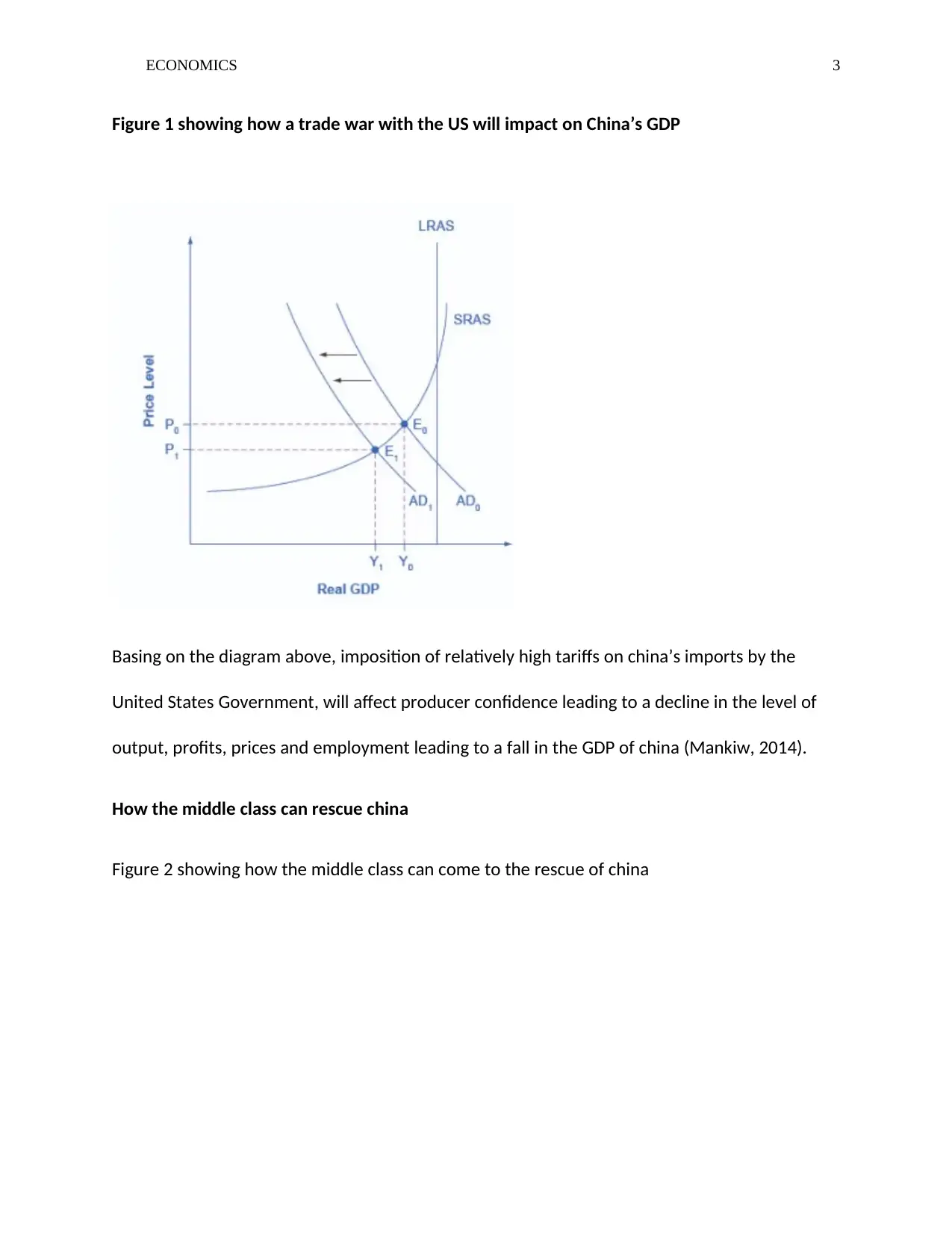
ECONOMICS 3
Figure 1 showing how a trade war with the US will impact on China’s GDP
Basing on the diagram above, imposition of relatively high tariffs on china’s imports by the
United States Government, will affect producer confidence leading to a decline in the level of
output, profits, prices and employment leading to a fall in the GDP of china (Mankiw, 2014).
How the middle class can rescue china
Figure 2 showing how the middle class can come to the rescue of china
Figure 1 showing how a trade war with the US will impact on China’s GDP
Basing on the diagram above, imposition of relatively high tariffs on china’s imports by the
United States Government, will affect producer confidence leading to a decline in the level of
output, profits, prices and employment leading to a fall in the GDP of china (Mankiw, 2014).
How the middle class can rescue china
Figure 2 showing how the middle class can come to the rescue of china
⊘ This is a preview!⊘
Do you want full access?
Subscribe today to unlock all pages.

Trusted by 1+ million students worldwide
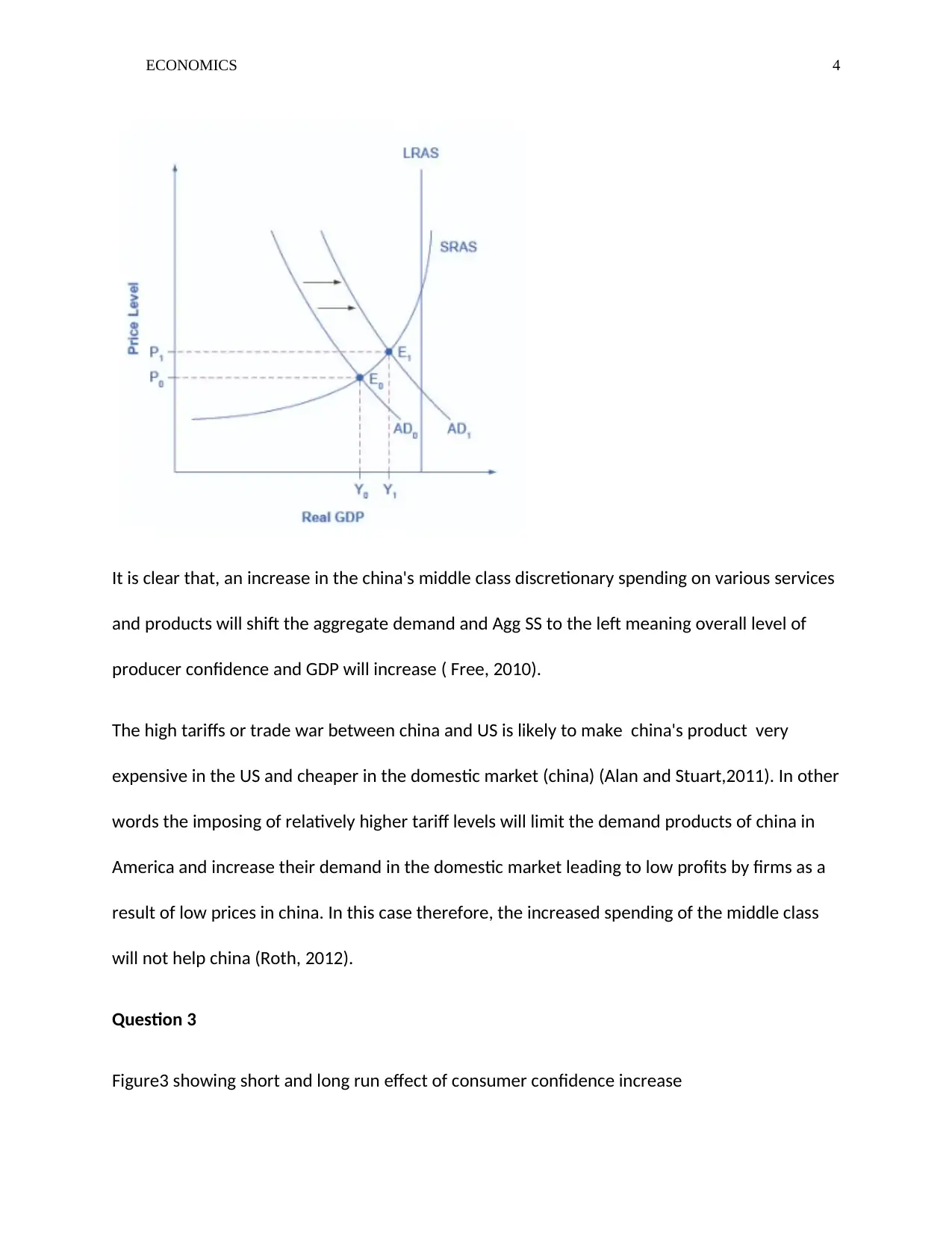
ECONOMICS 4
It is clear that, an increase in the china's middle class discretionary spending on various services
and products will shift the aggregate demand and Agg SS to the left meaning overall level of
producer confidence and GDP will increase ( Free, 2010).
The high tariffs or trade war between china and US is likely to make china's product very
expensive in the US and cheaper in the domestic market (china) (Alan and Stuart,2011). In other
words the imposing of relatively higher tariff levels will limit the demand products of china in
America and increase their demand in the domestic market leading to low profits by firms as a
result of low prices in china. In this case therefore, the increased spending of the middle class
will not help china (Roth, 2012).
Question 3
Figure3 showing short and long run effect of consumer confidence increase
It is clear that, an increase in the china's middle class discretionary spending on various services
and products will shift the aggregate demand and Agg SS to the left meaning overall level of
producer confidence and GDP will increase ( Free, 2010).
The high tariffs or trade war between china and US is likely to make china's product very
expensive in the US and cheaper in the domestic market (china) (Alan and Stuart,2011). In other
words the imposing of relatively higher tariff levels will limit the demand products of china in
America and increase their demand in the domestic market leading to low profits by firms as a
result of low prices in china. In this case therefore, the increased spending of the middle class
will not help china (Roth, 2012).
Question 3
Figure3 showing short and long run effect of consumer confidence increase
Paraphrase This Document
Need a fresh take? Get an instant paraphrase of this document with our AI Paraphraser
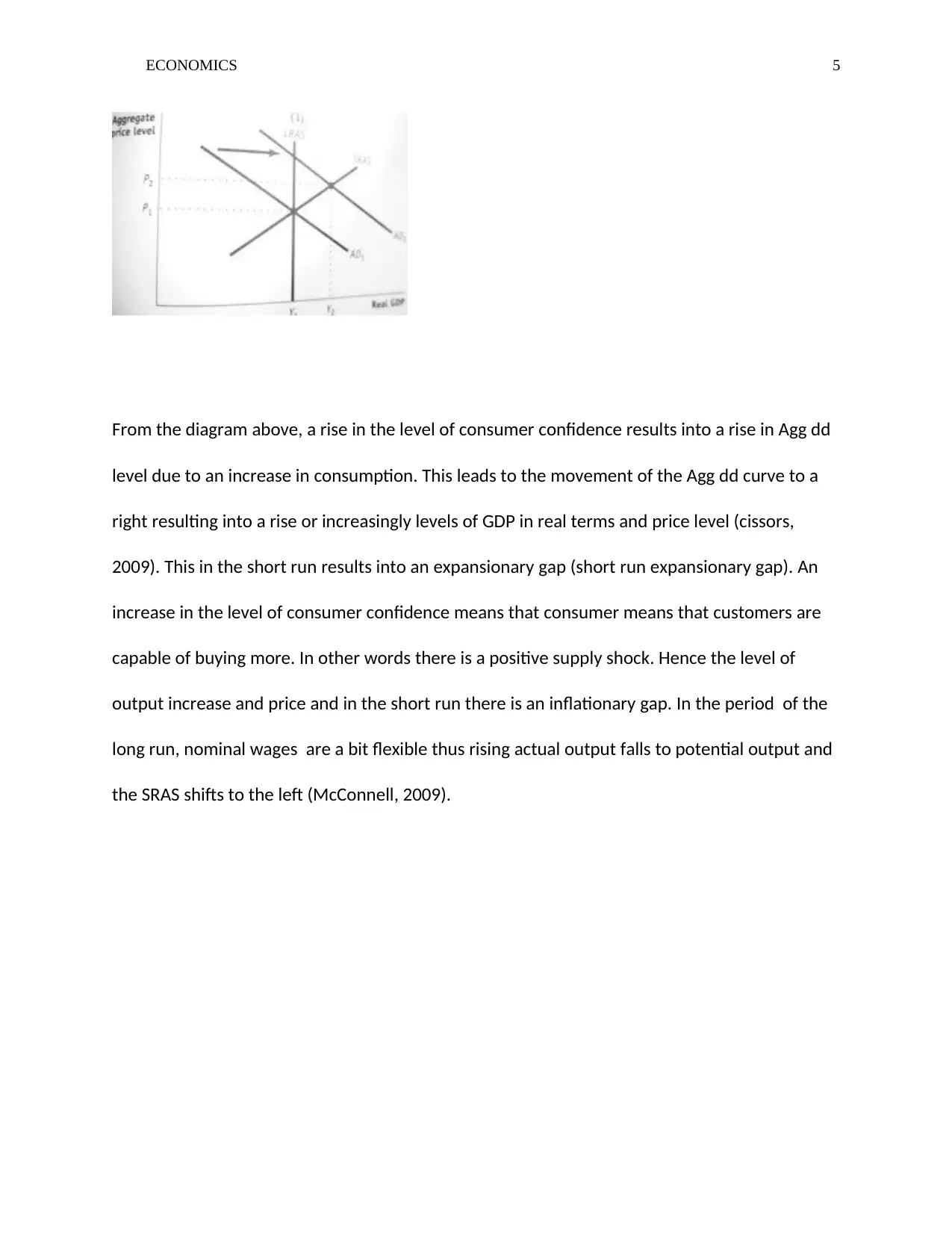
ECONOMICS 5
From the diagram above, a rise in the level of consumer confidence results into a rise in Agg dd
level due to an increase in consumption. This leads to the movement of the Agg dd curve to a
right resulting into a rise or increasingly levels of GDP in real terms and price level (cissors,
2009). This in the short run results into an expansionary gap (short run expansionary gap). An
increase in the level of consumer confidence means that consumer means that customers are
capable of buying more. In other words there is a positive supply shock. Hence the level of
output increase and price and in the short run there is an inflationary gap. In the period of the
long run, nominal wages are a bit flexible thus rising actual output falls to potential output and
the SRAS shifts to the left (McConnell, 2009).
From the diagram above, a rise in the level of consumer confidence results into a rise in Agg dd
level due to an increase in consumption. This leads to the movement of the Agg dd curve to a
right resulting into a rise or increasingly levels of GDP in real terms and price level (cissors,
2009). This in the short run results into an expansionary gap (short run expansionary gap). An
increase in the level of consumer confidence means that consumer means that customers are
capable of buying more. In other words there is a positive supply shock. Hence the level of
output increase and price and in the short run there is an inflationary gap. In the period of the
long run, nominal wages are a bit flexible thus rising actual output falls to potential output and
the SRAS shifts to the left (McConnell, 2009).
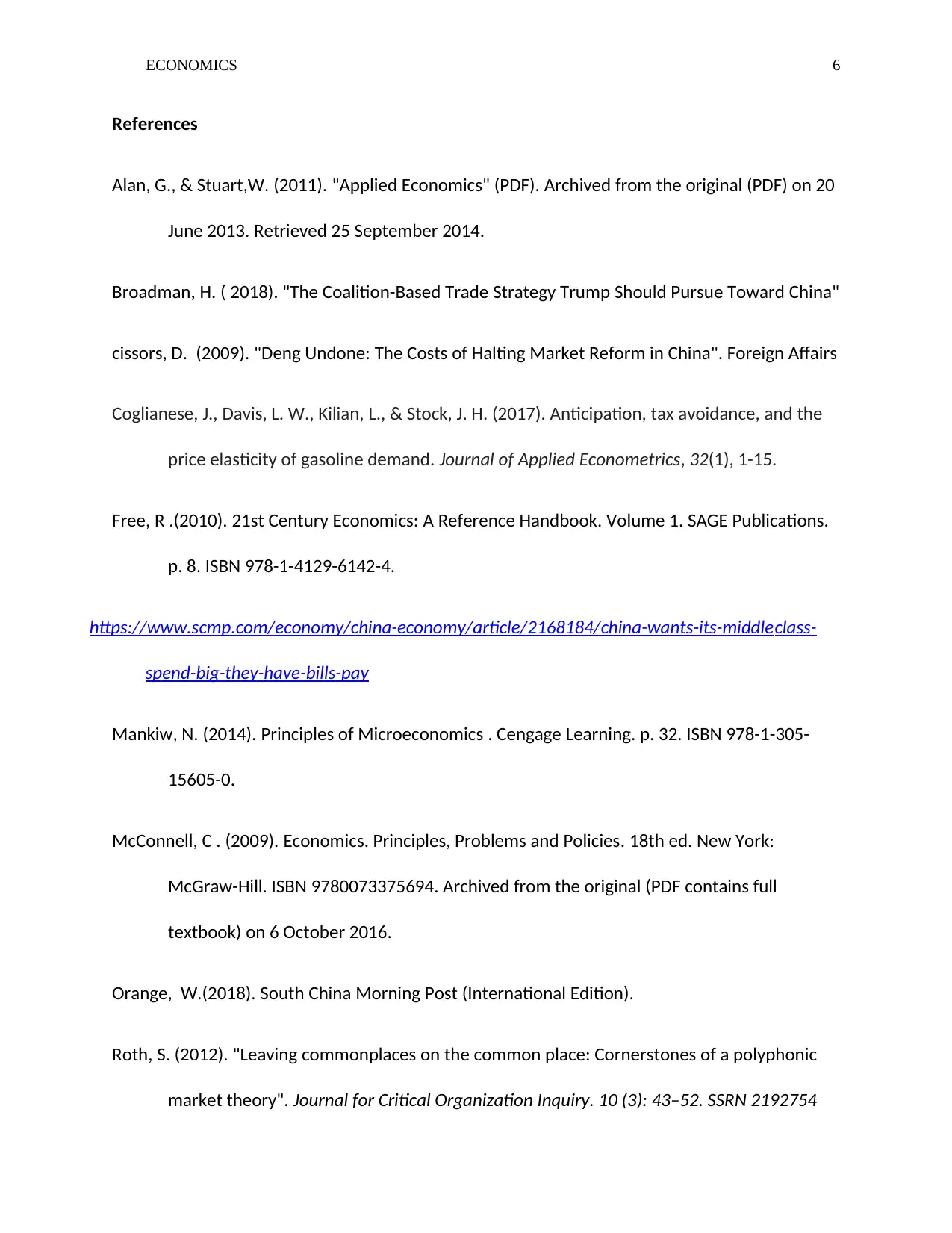
ECONOMICS 6
References
Alan, G., & Stuart,W. (2011). "Applied Economics" (PDF). Archived from the original (PDF) on 20
June 2013. Retrieved 25 September 2014.
Broadman, H. ( 2018). "The Coalition-Based Trade Strategy Trump Should Pursue Toward China"
cissors, D. (2009). "Deng Undone: The Costs of Halting Market Reform in China". Foreign Affairs
Coglianese, J., Davis, L. W., Kilian, L., & Stock, J. H. (2017). Anticipation, tax avoidance, and the
price elasticity of gasoline demand. Journal of Applied Econometrics, 32(1), 1-15.
Free, R .(2010). 21st Century Economics: A Reference Handbook. Volume 1. SAGE Publications.
p. 8. ISBN 978-1-4129-6142-4.
https://www.scmp.com/economy/china-economy/article/2168184/china-wants-its-middleclass-
spend-big-they-have-bills-pay
Mankiw, N. (2014). Principles of Microeconomics . Cengage Learning. p. 32. ISBN 978-1-305-
15605-0.
McConnell, C . (2009). Economics. Principles, Problems and Policies. 18th ed. New York:
McGraw-Hill. ISBN 9780073375694. Archived from the original (PDF contains full
textbook) on 6 October 2016.
Orange, W.(2018). South China Morning Post (International Edition).
Roth, S. (2012). "Leaving commonplaces on the common place: Cornerstones of a polyphonic
market theory". Journal for Critical Organization Inquiry. 10 (3): 43–52. SSRN 2192754
References
Alan, G., & Stuart,W. (2011). "Applied Economics" (PDF). Archived from the original (PDF) on 20
June 2013. Retrieved 25 September 2014.
Broadman, H. ( 2018). "The Coalition-Based Trade Strategy Trump Should Pursue Toward China"
cissors, D. (2009). "Deng Undone: The Costs of Halting Market Reform in China". Foreign Affairs
Coglianese, J., Davis, L. W., Kilian, L., & Stock, J. H. (2017). Anticipation, tax avoidance, and the
price elasticity of gasoline demand. Journal of Applied Econometrics, 32(1), 1-15.
Free, R .(2010). 21st Century Economics: A Reference Handbook. Volume 1. SAGE Publications.
p. 8. ISBN 978-1-4129-6142-4.
https://www.scmp.com/economy/china-economy/article/2168184/china-wants-its-middleclass-
spend-big-they-have-bills-pay
Mankiw, N. (2014). Principles of Microeconomics . Cengage Learning. p. 32. ISBN 978-1-305-
15605-0.
McConnell, C . (2009). Economics. Principles, Problems and Policies. 18th ed. New York:
McGraw-Hill. ISBN 9780073375694. Archived from the original (PDF contains full
textbook) on 6 October 2016.
Orange, W.(2018). South China Morning Post (International Edition).
Roth, S. (2012). "Leaving commonplaces on the common place: Cornerstones of a polyphonic
market theory". Journal for Critical Organization Inquiry. 10 (3): 43–52. SSRN 2192754
⊘ This is a preview!⊘
Do you want full access?
Subscribe today to unlock all pages.

Trusted by 1+ million students worldwide
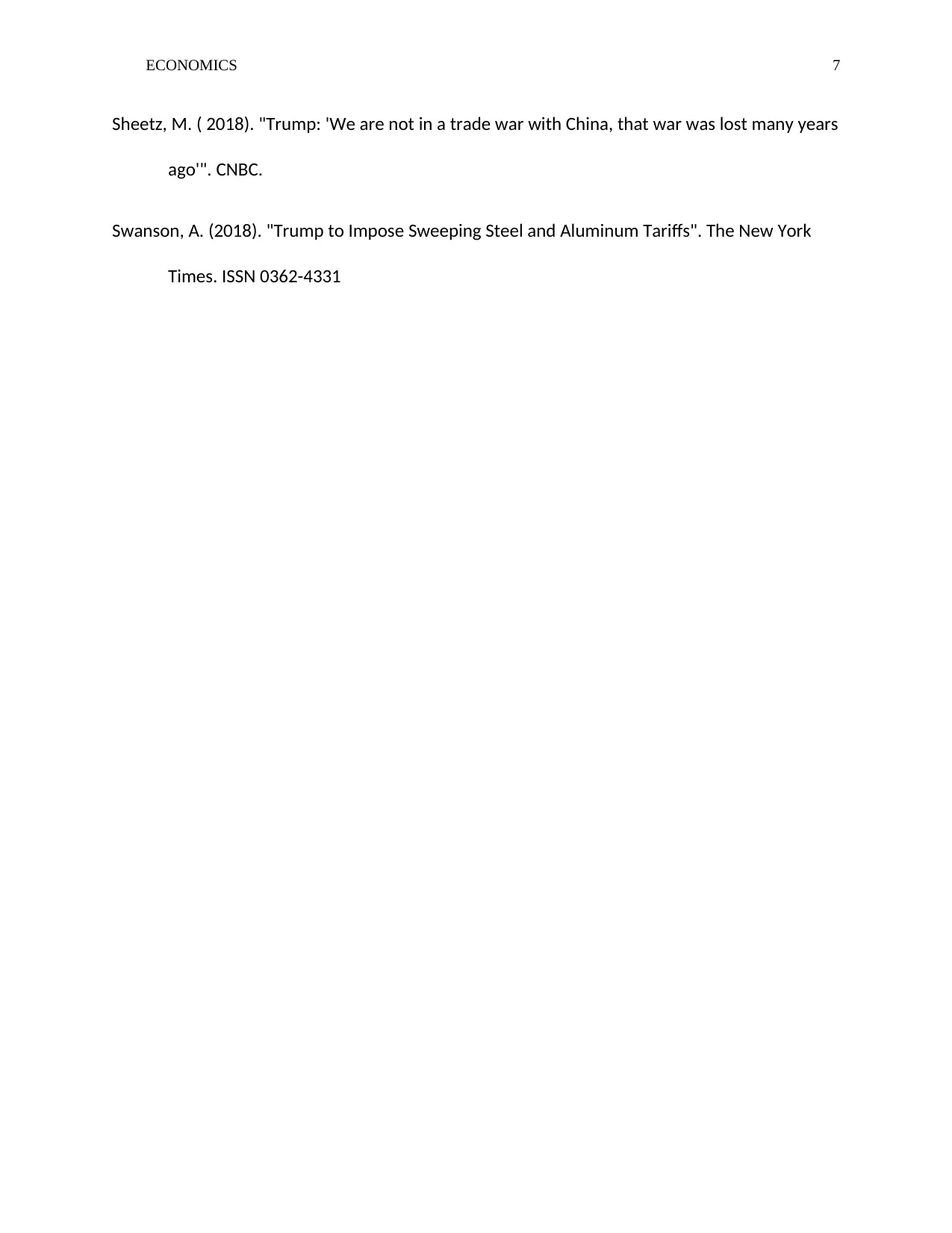
ECONOMICS 7
Sheetz, M. ( 2018). "Trump: 'We are not in a trade war with China, that war was lost many years
ago'". CNBC.
Swanson, A. (2018). "Trump to Impose Sweeping Steel and Aluminum Tariffs". The New York
Times. ISSN 0362-4331
Sheetz, M. ( 2018). "Trump: 'We are not in a trade war with China, that war was lost many years
ago'". CNBC.
Swanson, A. (2018). "Trump to Impose Sweeping Steel and Aluminum Tariffs". The New York
Times. ISSN 0362-4331
1 out of 7
Related Documents
Your All-in-One AI-Powered Toolkit for Academic Success.
+13062052269
info@desklib.com
Available 24*7 on WhatsApp / Email
![[object Object]](/_next/static/media/star-bottom.7253800d.svg)
Unlock your academic potential
Copyright © 2020–2025 A2Z Services. All Rights Reserved. Developed and managed by ZUCOL.




